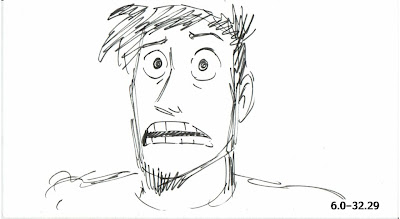So looking back on these is odd. At the time when us storyboard artists were doing these rough quick sketches they were the only version of the characters and their personalities that existed anywhere. But now seeing the finished film, and the layers that the art department, layout, animation and everyone else added later, these look like crude cave paintings. Especially because they were done quickly and roughly and in a big hurry....because of all those departments waiting to get to work on the film!
So in this case I had script pages, and luckily they were good script pages by the great Dan Fogelman. After Dan, the Directors and us Story Artists spent weeks talking and talking and talking about the characters and who they would be and what made them tick, Dan went off and very quickly wrote script pages. He was the first to try and nail down their voices in script form. And he did a great job.
Here's a few selected sketches from when Rapunzel and Flynn meet.




































Rapunzel: "Who are you-"

Rapunzel: "and how did you find me?"

Flynn: "Okay, uh, so let me assure you..."

Flynn: "I know not who you are, nor how I came to find you, but may I just say..."

Flynn: "Hi."

This last drawing of Flynn really represents our original concept of Flynn. In the beginning, we were really focused on making sure he was funny. We wanted to avoid making a film where the side characters provide all the humor and the main characters are straight and unfunny and feel like they're in a different movie than the side characters. So in our efforts to give Flynn a comedic conceit, we conceived him as a ladies man, self-centered because he's good looking and knows it. He even used to brag about all his "conquests" in that version.
He was very funny, but we quickly realized how unlikeable that type of guy can be, and how he was too one-dimensional to work in the larger sense of our movie. That guy was so shallow and obnoxious that you didn't want Rapunzel to end up with him. So we fleshed him out, give him vulnerability and a more sensitive side that made him warmer and more bearable to spend time with and made him the kind of guy who would deserve to be loved by a girl like Rapunzel. But we always tried to hang onto what made him funny too.

But this early drawing stayed in the story reels because it always got a laugh and it was clear, but as my conception of Flynn changed I never would have drawn him this way later on in the film's production. It's an extremely aggressive pose, with the neck thrust out toward Rapunzel and the chin stuck forward in an arrogant and aggressive manner. I would have drawn it differently if I had boarded it later, and when it was animated it was done in a more restrained and charming way, and not nearly as obnoxiously. Also, for speed I did all these drawings in pen on very small pads of paper (they're 3 inches by 5 inches) and I think the small size made me caricature things quite a bit and made the drawings extra expressive.
In the beginning days of drawing Flynn, I thought sometimes for inspiration about a cameo Clive Owen did on the show "Extras", where he played himself. In the scene, he's on a movie set, and the director is trying to find an extra to play a woman Clive has spent the night with. Clive is unhappy about the situation because, in his opinion, none of the extras is attractive enough for him to have actually slept with. This clip is definitely NSFW (language).
The girl that's standing there taking all the abuse through the scene is one of the main characters in the show, and the fact that you know her and like her makes the scene work within the context of the show. It's a great example of how point of view makes something work sometimes. The fact that you see her reactions to be talked about like a piece of meat is what makes it funny and painful (instead of just painful).
Another funny thing to point out is how, in the finished film, Pascal doesn't jump away to hide from Flynn, he just changes color. That's the type of thing I see in the finished film and it makes me wonder why I never thought of that in all the hundreds of times I watched that scene in the story room and in editorial and even as I drew it. It's so simple and obvious that I just never thought of it. It's a stroke of obvious genius.
As a storyboard artist you want to get as many things right as you can: nail down the characters and their relationships and their personalities, of course, as well as all the story events, but also the staging, the layout and the look of everything as best you can. The more you can give the departments that come after you, the less time they have to spend inventing things out of thin air and the more time they can spend adding those great layers to what we've given them and turn our initial thoughts into the beautiful and nuanced end product.